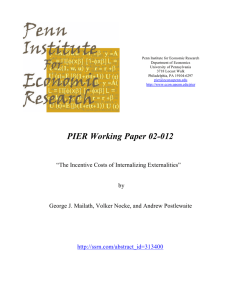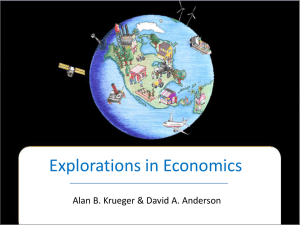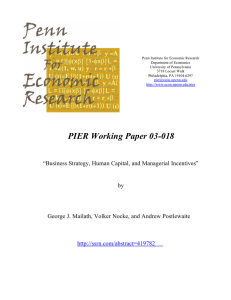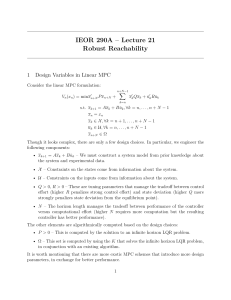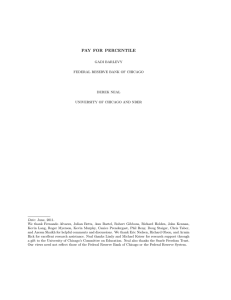Document 11243410
advertisement
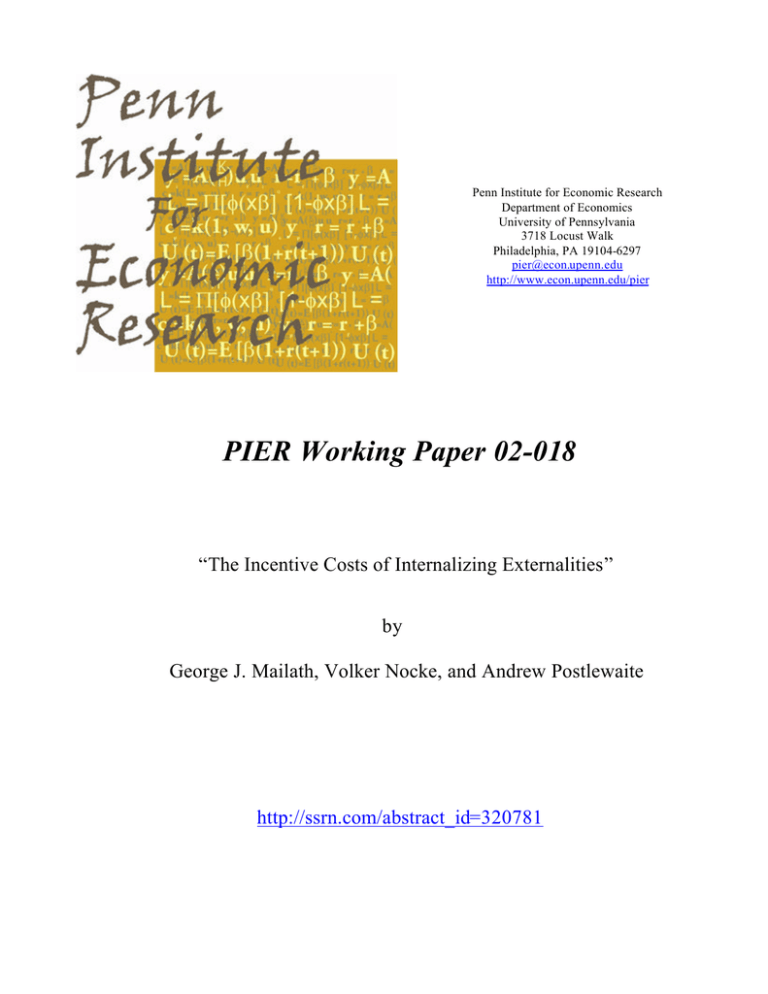
Penn Institute for Economic Research
Department of Economics
University of Pennsylvania
3718 Locust Walk
Philadelphia, PA 19104-6297
pier@econ.upenn.edu
http://www.econ.upenn.edu/pier
PIER Working Paper 02-018
“The Incentive Costs of Internalizing Externalities”
by
George J. Mailath, Volker Nocke, and Andrew Postlewaite
http://ssrn.com/abstract_id=320781
The Incentive Costs of Internalizing Externalities∗
George J. Mailath†
University of Pennsylvania
Volker Nocke‡
University of Pennsylvania
Andrew Postlewaite§
University of Pennsylvania
First version: May 20, 2002
This version: July 11, 2002
Abstract
We present a dynamic agency model in which changes in the structure of a firm
affect its value due to altered incentives. There may be disadvantages in merging two
firms even when such a merger allows the internalization of externalities between
the two firms. Merging, by making unprofitable certain decisions, increases the
cost of inducing managers to exert effort. This incentive cost arises as a natural
consequence of the manager’s firm-specific human capital.
∗
Mailath and Postlewaite gratefully acknowledge support from National Science Foundation Grant
#SES 0095768. We wish to thank Franklin Allen, Oliver Hart, David Martimort, Steven Matthews,
Meg Meyer, Kevin J. Murphy, Sönje Reiche, John Roberts, and Huanxing Yang for valuable discussions
and comments.
†
gmailath@econ.upenn.edu
‡
nocke@econ.upenn.edu
§
apostlew@econ.upenn.edu
1. Introduction
Mergers between competing firms sometimes create value by internalizing externalities.
We argue here that this internalization may also decrease managers’ incentives through
its impact on their human capital, offsetting the increased value. To fix ideas, consider
the effects of a merger between the American television networks CBS and ABC. There is
strong “late-night” competition between CBS, ABC, and the third major network, NBC.
Two of the networks, CBS and NBC compete via entertainment shows (The Late Show
with David Letterman and The Tonight Show with Jay Leno, respectively), while ABC
broadcasts a “highbrow” news program Nightline featuring Ted Koppel. It is commonly
believed that the entertainment programs are substantially more profitable than the
news program, and as a consequence, there are recurrent rumors that the news program
might be replaced by a program that is more entertainment oriented.1 Replacing or
reorienting the program would likely have several effects. First, the combined profit
of the three networks would probably decrease, since the reduction in variety offered
is likely to result in a smaller number of viewers of all networks combined. Second,
the producer of Nightline would see a decline in the value of his human capital. He
currently has a relationship with a large number of people who can be called upon to
provide expertise for a wide variety of topics that might be covered on the program.
Those relationships have dramatically lower value should ABC make a strategic change
and reorient the news program to include more entertainment content.
The possible destruction of some of his human capital may provide the producer of
Nightline an incentive, above and beyond any direct financial incentives, to make that
program a success. The incentive is operative whenever it is optimal for the network to
reorient Nightline after sufficiently low ratings. The threat of reorientation thus reduces
the cost to ABC of inducing any given effort level from the producer.
We turn now to the effect of a merger of ABC with one of the other networks, say
CBS. There is an obvious advantage of such a merger, namely the internalization of
externalities. In the absence of any merger, by maximizing its stand-alone profits, each
network ignores any cannibalization of the other network’s audience. After a merger,
cannibalization is taken into account, and any decision will maximize the joint profits
of the two networks. For example, if ABC reoriented Nightline, ABC might well see
its profits increase, but at least some of the increase in profits would likely come from
the rival networks. If the combined profit of ABC and CBS was reduced by such a
reorientation, a merged firm would take this into account and not reorient Nightline.
But in this case, the producer of Nightline need not worry (or not worry as much) about
1
Indeed, in February-March 2002, ABC tried to lure David Letterman from CBS. A detailed discussion can be found in the articles “How ABC’s Full-Court Press Almost Landed Letterman” and
“Doubted as Business, Valued as Asset, Network News Will Be Hard to Displace”, both in The New
York Times, March 18, 2002, page C1.
1
a decrease in the value of his human capital in the event that the program performs
poorly. The implicit (credible) threat that the program will be reoriented following
poor performance has vanished, and consequently, direct financial incentives must be
increased to induce the premerger effort level.
More generally, the optimality of any business plan for a firm will depend upon
many aspects of a firm. Changes in the structure of a firm (such as a merger) will affect
the optimality of various business plans. Because changes in the business plan alter the
effectiveness of workers’ human capital within the firm, such changes in the structure
of the firm affect the optimal contracts within the firm. We illustrate and discuss the
incentive effects that accompany such redeployment in the context of a merger between
firms that allows for the internalization of externalities. We should also emphasize that
while we focus on negative incentive effects, positive incentive effects are also possible.
We present the model in the next section and demonstrate the differences in the
optimal contracts under different organizational structures. In section 3, we discuss
related literature and then conclude, in section 4, with a general discussion.
2. Dynamic Agency
We first describe a dynamic principal-agent relationship in which the owner ignores
any externalities. The manager exerts either high (H) or low (L) effort in each of two
periods. At the end of each period, there is a binary signal stochastically related to that
period’s effort. The signal in period t is denoted yt and we interpret it as indicating
the success, s, or failure, f , of that period’s project. At the end of the first period, and
knowing the realization of y1 , the owner either maintains the current business plan (i.e.,
continue with the status quo) or introduces a new one. We refer to the former choice
as the passive action and the second as the active action (we also say that the owner
is passive or active). The generic action is denoted α ∈ {a, p}, with p denoting the
passive action, and a the active action. The manager knows whether the owner is active
or passive when making his second period effort choice. The manager has firm-specific
human capital, the value of which is affected by the owner’s strategy.2 Specifically, we
assume the manager is more effective under the current business plan than under the
new business plan.3 The probabilities of success in the first period, ρe , and in the second
period, ρpe and ρap , are independent and given by:
2
“Business-plan specific human capital” might be a better term since the value of the manager’s
human capital depends not only on the firm, but also on the firm’s strategy.
3
Part of the manager’s human capital is his knowledge of the current business practices, which may
diminish drastically for some changes in strategy. A manager of a manufacturing firm who has a personal
relationship with all the major customers of the firm will be less valuable if the firm decides to have all
sales done on the web, or if the firm decides to outsource the marketing of the product.
2
Period 1
ρe
0.3
0.9
e
low effort
high effort
Period 2
passive, ρpe active, ρae
.
0.3
0.1
0.9
0.7
While not necessary for the analysis, it is convenient to think of the returns as
accruing over time. Under this interpretation, the action of the owner at the end of the
first period affects first, as well as second, period returns. For example, the choice to
be active (introduce a new business plan) may require immediate asset reallocations by
the owner. We assume the new business plan increases first period returns if the first
signal is a failure. At the same time, the new business is riskier in that the payoffs are
more extreme in the second period than under the original business plan.
outcomes (y1 , y2 )
failure, failure
success, failure
failure, success
success, success
Period 1 returns
Period 2 returns
passive
0
300
0
300
passive
50
50
350
350
active
50
170
50
175
active
0
25
400
425
Total returns
π (y1 y2 |α)
passive active
50
50
350
195
350
450
650
600
Finally, both agents are risk neutral, with the manager’s disutility of high effort in any
period given by 120.
As in the standard moral hazard model, the effort level chosen by the manager is noncontractible. However, the outcome of each project (whether it was a failure or success)
is observable to both the owner and manager and verifiable to third parties. Crucially,
we assume that the owner’s action at the interim stage is both ex post as well as ex ante
non-contractible.4 This is similar to Aghion, Dewatripont, and Rey (2001), and differs
from the Grossman-Hart-Moore models of incomplete contracts, where certain actions
are ex-ante non-contractible, but ex-post contractible. This implies that in any contract,
wages can only be a function of the realizations of the signals in the two periods, y1 and
y2 ; wages cannot depend on the action of the owner.
The manager’s compensation (or wage) is denoted by w(y1 y2 ). The manager has
limited liability, so w(y1 y2 ) ≥ 0 for all y1 and y2 . The owner’s payoff is
π(y1 y2 |α) − w(y1 y2 ),
and the payoff of the manager is
4
w(y1 y2 ) − c(e1 ) − c(e2 ),
This requires that the final payoffs to the firm are non-verifiable.
3
where et ∈ {L, H} is the effort in period t, and c (L) = 0 and c (H) = 120.
We now calculate the owner’s optimal take-it-or-leave-it offer w(y1 y2 ) to her manager.
It is straightforward to show that the owner optimally pays the manager just enough
to induce him to exert high effort in both projects. Moreover, the owner will take the
passive action, p, in the event of success of the first project, and the active action, a, in
the event of failure.
In order to induce the manager to exert high effort in the second project, the owner
optimally offers the minimum possible compensation in case the project turns out to
be a failure. That is, w(f f ) = w(sf ) = 0. For the manager to exert high effort in
the second project, wages in the event of success in the second period, w(y1 s), have to
satisfy the following incentive constraints:
ρpH w (ss) − c (H) ≥ ρpL w (ss)
(1)
ρaH w(f s) − c(H) ≥ ρaL w(f s).
(2)
and
To provide optimal incentives for the first agency problem, the owner offers, in the event
of failure in the first period, the minimum possible wage consistent with the incentive
constraint of the second agency problem,
w(fs) =
120
c(H)
= 200.
=
a
− ρL
0.7 − 0.1
ρaH
It remains to determine the wage payment if both signals are successful. The wage
w(ss) will be chosen so as to satisfy the following incentive constraint (for the first
agency problem) with equality:5
≥
ρH ρpH w(ss) + (1 − ρH ) ρaH w(f s) − c(H)
(3)
ρL ρpH w(ss) + (1 − ρL ) ρaH w(fs).
This wage is thus given by
ρaH
c(H)
+
w(fs)
(ρH − ρL ) ρpH
ρpH
= 3400/9 ≈ 377.78.
w(ss) =
It is useful to calculate the optimal wage contract assuming the owner is passive
after any realization of the first period signal. We denote this wage by ŵ. As above, it
is immediate that
ŵ (f f ) = ŵ (sf ) = 0
5
Since the manager will exert high effort in the second period irrespective of the realization of the
first period signal, the disutility of second period high effort can be ignored.
4
and
ŵ (fs) =
c(H)
120
= 200.
p =
0.9 − 0.3
− ρL
ρpH
Turning to the wage ŵ (ss), we have
ŵ(ss) =
c(H)
3800
≈ 422.22.
p + w(f s) =
9
(ρH − ρL ) ρH
Note that (second period) high effort is less effective with an active owner. If a first
period signal of f results in the owner being active, the opportunity cost of low effort in
the first period is not only an increase in the probability of a first period signal of f , but
also a reduction in the effectiveness of second period effort, and so a further reduction
in expected wages. On the other hand, if the owner is necessarily passive, this further
reduction in expected wages from first period low effort does not occur, and so the wage
after ss must be increased to obtain the same incentive effect.
For future reference, the expected payoff to the owner under the wage w is
¡
©
¢
ª
ρH ρpH (π (ss|p) − w (ss)) + 1 − ρpH (π (sf |p) − w (sf ))
+ (1 − ρH ) {ρaH (π (fs|a) − w (f s)) + (1 − ρaH ) (π (ff |a) − w (ff ))}
= 271,
while the expected payoff for a necessarily passive owner, i.e., the expected payoff under
ŵ, is 230.
2.1. Internalizing the externality
The choice of business plan by the owner has implications for economic agents other
than the manager. For example, a rival firm may be hurt by a new business plan. Again,
to keep things simple we assume that active choice imposes a negative externality of 200
on another firm. Under separate ownership, the owner ignores this externality, and, as
described above, offers the wage contract w to the manager, and after a negative first
period signal chooses the active action.
We now consider the impact of joint ownership (where the two firms have the same
owner) on both the manager and the owner of the firm. Note that, as in Grossman
and Hart (1986), the ownership structure does not affect the set of variables that can
be contracted upon. Ownership only changes the identity of the individual who has
residual rights of control.
Joint ownership implies that the negative externality the active action imposes on
the other firm will be internalized. Intuitively, the active action is less attractive under
joint ownership than under separate ownership. For the problem at hand, this will
imply that joint ownership cannot replicate the outcome under separate ownership.
5
Suppose the owner offers the manager the wage contract w. After a negative first
period signal, the owner must decide between the passive and active actions. Denote by
V the value of the second firm when the owner is passive. This value V is assumed to
be independent of the ownership structure.6 The expected payoff from the active choice
(which is what the owner would do in the absence of the externality) is then given by
ρaH (π (f s|a) − w (f s)) + (1 − ρaH ) (π (f f |a) − w (ff )) + V − 200 = V − 10,
while the expected payoff from being passive is
¢
¡
ρpH (π (f s|p) − w (f s)) + 1 − ρpH (π (ff |p) − w (f f )) + V = V + 140
(the payment of 200 after fs is sufficient to obtain high effort in the second period,
irrespective of the action choice of the owner).
Thus, the manager faced with a wage contract of w does not exert high effort in
the first period (since w (ss) < ŵ (ss)). Consequently, the owner offers the manager the
wage contract ŵ, always chooses the passive action, and (since there is no externality
from passive behavior) the expected payoff is
230 + V.
Under separate ownership, the firm imposes a negative externality on the other firm
if and only if the first period signal is negative. The expected value of the externality
is thus (1 − ρH )(−200) = −20. The combined value of the two firms under separate
ownership is then given by
271 + V − 20 = 251 + V,
and so the internalization of the externality results in a lower total value.
The prospect of the active (instead of the passive) action in the event of failure
motivates the manager to exert high effort as it reduces the rent the manager can ensure
himself in the continuing relationship with the owner. In this sense, the active action
acts as a disciplining device. However, the active action is no longer credible under joint
ownership. It follows that the manager must be paid more under joint ownership (if the
owner wants him to exert high effort) – which more than outweighs the potential gain
from joint ownership.
Observe that the merger does not obtain although it is “efficient” in that the sum of
the managers’ and owners’ payoffs is higher under joint ownership than under separate
ownership. This inefficiency arises because of non-contractibilities.
6
This assumption can easily be relaxed. For instance, our conclusion would be unchanged if both
firms are symmetric. In this case, V would be higher under separate ownership than under joint
ownership.
6
3. Related Literature
Our paper is in the tradition of the literature on the boundaries of the firms; see
Williamson (1975, 1985), Klein, Crawford, and Alchian (1978), Grossman and Hart
(1986), and Hart and Moore (1986). Hart (1995) provides a nice survey of this literature. The main insight of the modern property rights approach, pioneered by Grossman
and Hart (1986), is that property rights (and hence ownership) matter when contracts
are incomplete. In more recent work on relational contracts, Halonen (1995) and Baker,
Gibbons, and Murphy (2002) show that this insight continues to hold even in a repeated
game setting. While we also consider a dynamic agency problem, in our setting, the
owner’s decision (following the first agency problem) constitutes a state variable which
alters the continuation game that players subsequently play. Thus, in our model, players
are engaged in a dynamic game, in contrast with most previous literature, which typically employed repeated games. This distinction is important because the phenomenon
under study arises precisely from the change in the continuation game induced by the
owner’s behavior.
It should be noted that the conflict between the owner and the manager in our
model is not the result of a holdup problem, unlike much of the related literature.7 We
also depart from much of the property rights literature by focussing on the link between
agency problems and firm boundaries.
In recent work, Hart and Holmstrom (2002) present a model in which workers have
preferences over firm policies and managers care about workers’ interests. In their
model, integration may not be optimal since workers’ and managers’ preferences are,
by assumption, more difficult to align in an integrated firm. Hart and Holmstrom
incorporate nonstandard variables in the utility functions of the actors; in contrast,
managers and owners have preferences only over money and the disutility of effort as in
the standard moral hazard problem in our model. A second distinction is that, unlike
Hart and Holmstrom, agency problems are at the heart of our paper.
Our paper is also related to the recent finance literature on internal capital markets
(see, for example, Stein (1997), Scharfstein and Stein (2000), and in particular Brusco
and Panunzi (2001)). This literature shows that “winner picking” among different
investment projects in a conglomerate firm may reduce managers’ incentives to exert
effort.8 As in our paper, there may be a reallocation of assets after the outcome of
the agency problem is observed. The paper closest to our model is Brusco and Panunzi
7
It has recently been argued that there has been an over-emphasis on the holdup problem in understanding organizational structure: “It seems to us that the theory of the firm, and especially work on
what determines the boundaries of the firm, has become too narrowly focused on the hold-up problem
and the role of asset specificity” (Holmstrom and Roberts (1998)).
8
Meyer, Milgrom, and Roberts (1992) present an early model showing why winner picking may have
adverse incentive effects (namely, by encouraging influence activities at the expense of productive effort).
7
(2001), in which after a successful realization of the project there is a chance that some of
the returns are allocated to other projects, and consequently, the nonpecuniary benefit
accruing to the manager is diminished. This is reminiscent of the owner’s decision
to reallocate assets in our model. As in Hart and Holmstrom, these finance papers
incorporate variables in the utility function in addition to those in the standard moral
hazard model (money and effort). In contrast, in our model, there are no psychic
benefits.
The idea that a principal’s inability to commit to some future action has negative
incentive consequences plays a central role in Dewatripont and Maskin (1995). In particular, an investor (creditor) would like to commit not to refinance a bad project (so
as to ensure that the better-informed entrepreneur does not choose such a project in
the first place). However, such commitment by the investor may not be credible since,
at the time of financing, some of the investment costs are already sunk and so it may
be efficient to continue the bad project. The authors show that a decentralized credit
market in which no single creditor has sufficient funds to fully finance the project, the
moral hazard problem can be ameliorated.
It has been observed before that structural changes that improve efficiency ex post
may reduce efficiency overall in a dynamic setting due to adverse effects on ex ante incentives (see, e.g., Cremer (1995), Olsen and Torsvik (1995), Meyer, Olsen, and Torsvik
(1996), Olsen (1996), and Meyer and Vickers (1997)). The closest to our work is Olsen
(1996), who shows that (vertical) integration may not be profitable even though it facilitates the realization of complementarity gains: by changing the set of ex post efficient
actions, integration can aggravate the ratchet effect. In contrast, in our model the agent
(manager) has no private information. Here, what makes the integration potentially disadvantageous is that agency costs increase following a merger due to a reduction of the
manager’s business-plan specific human capital.
4. Discussion
1. We analyzed a model in the value of a manager’s human capital is affected by changes
in the deployment of the firm’s assets. Because of the link between firm organization
and the value of managers’ human capital, the internalization of externalities affects
ex ante incentives by altering the set of actions that will be taken ex post. If the
internalization of externalities is not contractible, organizational structure can have ex
ante incentive effects by affecting the extent to which externalities will be internalized
ex post. While we have focussed on incentive costs, these incentive effects can in general
be either positive or negative. In our model, a certain (disciplining) action that imposes
a negative externality on both the rival firm and the manager is optimal for the owner
in the event of failure under separate ownership, but not under joint ownership. In
contrast, a positive incentive effect of internalizing externalities would have resulted
8
if we had assumed that the active action (which reduces the manager’s rent in the
ongoing relationship) imposes a positive externality on the rival firm, and is taken only
under joint ownership in the event of failure of the first period project. More generally,
the incentive effects of internalizing externalities could be either positive or negative
depending on (i) whether the active action imposes a positive or negative externality
on the rival firm, (ii) whether the active action increases or reduces the manager’s
rent in his ongoing relationship with the owner, and (iii) whether the internalization of
externalities affects the action taken by the owner in the event of failure or in the event
of success of the first period project.
2. It is not just mergers that can affect the value of managers’ human capital, and
consequently, their incentives; a similar issue may arise between two divisions within a
single firm. Consider a situation with a single firm with two divisions, each with a two
level managerial structure. Replace the owners of the two firms in our model with top
level managers, each with a low level manager as in our model. Suppose that these top
level managers have an effort choice, and to induce efficient effort, the managers must
be given an equity share of their division, and that the structure of the payoffs when
the managers take these efficient effort choices is as in our model.
When there are two separate top managers, the cost of providing incentives for
the low level managers is as in our analysis. However, if one institutes a different
firm structure with a single top manager, it becomes more costly to induce efficient
effort choices for the low level manager. The reason is precisely as in our model: a
single top manager will (by assumption) necessarily have his compensation tied to the
performance of each of the divisions that he controls. But in this case, for any decision
he contemplates within one division, he will internalize the externalities of that decision
on the other division. By the same logic as in our analysis above, the set of actions that
might credibly be taken by managers may be smaller with a single top manager than
with separate managers for the divisions.
While we can translate our model to this case of multiple divisions within the firm,
there is an important difference between the two cases. If the top level decision maker
is a manager rather than an owner, the question of renegotiation arises. At the point
where the top manager is to take the active action, the owner will not want him to take
this action, since the owner cares about the negative externality this action imposes on
the other division. This contrasts with the merger case in which the top level decision
maker is the owner, and consequently is unaffected by the external effects of the active
action. If the active action is contractible ex post, it will not be taken, and hence the
potential disciplinary effect of the existence of the active action disappears. The only
way that there can remain a disciplinary effect of the active action is if that action is
not ex post contractible. In many situations this is likely to be the case. Consider,
for example, the Buick and Oldsmobile divisions of General Motors. The top manager
of the Buick division may understand well that design changes he is effecting might
9
increase demand for Buicks at the expense of the Oldsmobile division. It is difficult to
imagine a contract between the owners of General Motors and the head of the Buick
division that would eliminate the incentive to encroach on Oldsmobile’s customer base,
while still providing the Buick head incentives to increase sales in general.
3. The possibility that a decrease in business plan-specific human capital creates an
incentive for the manager to exert effort raises the question of whether a similar incentive
effect could be achieved by firing the manager after project failure. Firing the manager
would seem to be the ultimate in decreasing the value of his human capital. However,
even if the project fails, the manager may still have substantial firm-specific human
capital that the firm would be reluctant to lose. Hence, the firm and the manager would
find it in their interest to write a new contract following termination, and consequently
contracts that threaten termination are not renegotiation-proof.
4. For organizational structure to have any effect on decisions, it must be the case that
some actions cannot be contracted on. We discuss briefly the issue of noncontractibility
and the role it plays in our model.
A central issue is whether the manager(s) and the owner(s) can renegotiate at the
interim stage to take the efficient action, namely the passive action (independently of
the outcome of the project). We assume that such renegotiation is infeasible since the
owner’s action is ex post non-verifiable (which implies that it is neither ex ante nor
ex post contractible). It follows that ex post efficiency may not be obtainable.9 Our
assumption of non-contractibility is motivated by the observation that, in many circumstances, it is intrinsically hard to describe the “right” action in sufficient detail to
distinguish it from many seemingly similar actions with quite different payoff consequences. If it is intrinsically hard to describe the desired action, contracting to induce
that action may be impossible even after the state of the world is realized. Moreover, in
many contexts, it seems plausible that the owner of the firm (or the agent responsible
for taking the action) may not only choose from a large array of similar actions but
that she may have private information about the payoff consequences of the different
actions. This should limit, or even eliminate, any scope for contracts. It is for simplicity
that we assume that no contract can be written about the owner’s action.10
Note that our assumption is different from (but, as we see it, complementary to)
what is commonly assumed in the literature on property rights and the theory of the
9
As is well known, ex post inefficiency in certain states of the world may provide ex ante incentives.
In our model, this is the case under separate ownership: it is the ex post inefficient (active) action–in
the event of failure–which motivates the manager ex ante. Under joint ownership, the inefficient action
is no longer credible, and the manager has to be motivated by a larger monetary compensation in the
event of success.
10
Note that our assumption on contractibility is similar to standard moral hazard models in which
the agent’s effort is neither ex ante nor ex post contractible. In a recent paper, Aghion, Dewatripont,
and Rey (2001) also explore the assumption of ex ante and ex post non-contractibility. However, they
consider the case where control over a non-contractible action is transferable.
10
firm. Following Grossman and Hart (1986), much of the literature focusses on the holdup problem and (ex post) renegotiation. Consequently, the literature typically assumes
that certain actions are ex ante non-contractible but ex post contractible. It follows that,
in contrast to our model, ex post efficiency can easily be achieved via renegotiation. The
Grossman-Hart assumption of ex ante non-contractibility and ex post contractibility is
often motivated by reference to the idea that the (ex post efficient) action may be
difficult and/or costly to describe ex ante, possibly due to unforeseen contingencies.
However, once the state of the world is realized, the efficient action is easily describable
and verifiable.
References
Aghion, P., M. Dewatripont, and P. Rey (2001): “On Partial Contracting,”
Mimeo, Harvard University, UCL, and IDEI, Toulouse.
Baker, G., R. Gibbons, and K. J. Murphy (2002): “Relational Contracts and the
Theory of the Firm,” Quarterly Journal of Economics, 117(1), 39—84.
Brusco, S., and F. Panunzi (2001): “Reallocation of Corporate Resources and Managerial Incentives in Internal Capital Markets,” Mimeo, Universidad Carlos III and
University of Bologna.
Cremer, J. (1995): “Arm’s Length Relationships,” Quarterly Journal of Economics,
110(2), 275—295.
Dewatripont, M., and E. Maskin (1995): “Credit and Efficiency in Centralized and
Decentralized Economies,” Review of Economic Studies, 62(4), 541—555.
Grossman, S. J., and O. D. Hart (1986): “The Costs and Benefits of Ownership:
A Theory of Vertical and Lateral Integration,” Journal of Political Economy, 94(4),
691—719.
Halonen, M. (1995): “Reputation and the Allocation of Ownership,” STICERD Discussion Paper TE/289, London School of Economics.
Hart, O. (1995): Firms Contracts and Financial Structure, Clarendon Lectures in
Economics. Oxford University Press, Oxford.
Hart, O., and B. Holmstrom (2002): “Vision and Firm Scope,” Mimeo, Harvard
University and MIT.
Hart, O., and J. Moore (1990): “Property Rights and the Nature of the Firm,”
Journal of Political Economy, 98(6), 1119—1158.
11
Holmstrom, B., and J. Roberts (1998): “The Boundaries of the Firm Revisited,”
Journal of Economic Perspectives, 12(4), 73—94.
Klein, B., R. Crawford, and A. Alchian (1978): “Vertical Integration, Appropriable Rents, and the Competitive Contracting Process,” Journal of Law and Economics, 21(2), 297—326.
Meyer, M. A., P. Milgrom, and J. Roberts (1992): “Organizational Prospects,
Influence Costs, and Ownership Changes,” Journal of Economics & Management
Strategy, 1(1), 9—35.
Meyer, M. A., T. E. Olsen, and G. Torsvik (1996): “Limited Intertemporal
Commitment and Job Design,” Journal of Economic Behavior & Organization, 31(3),
401—417.
Meyer, M. A., and J. Vickers (1997): “Performance Comparisons and Dynamic
Incentives,” Journal of Political Economy, 105(3), 547—581.
Olsen, T. E. (1996): “Agency Costs and the Limits of Integration,” Rand Journal of
Economics, 27(3), 479—501.
Olsen, T. E., and G. Torsvik (1995): “Intertemporal Common Agency and Organizational Design,” European Economic Review, 39(7), 1405—1428.
Scharfstein, D., and J. Stein (2000): “The Dark Side of Internal Capital Markets:
Divisional Rent-Seeking and Inefficient Investment,” Journal of Finance, 55(6), 2537—
2564.
Stein, J. (1997): “Internal Capital Markets and the Competition for Corporate Resources,” Journal of Finance, 52(1), 111—133.
Williamson, O. (1975): Markets and Hierarchies: Analysis and Antitrust Implications. Free Press, New York.
(1985): The Economic Institutions of Capitalism. Free Press, New York.
12

